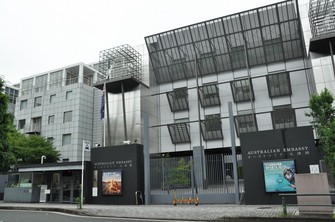
Kyoto Seika University Professor Emeritus Komei Hosokawa, center, guides two members of the Australian indigenous Yawuru people at Kyoto University’s Memorial Auditorium and Museum of Medicine in Kyoto’s Sakyo Ward, June 6, 2025. (Mainichi/Hiroyuki Ota)
The University of Tokyo and other institutions have returned the remains of overseas indigenous people that had been held for research purposes for about a century. Some of them were collected through inappropriate methods, and it must be said that the response has been too slow.
The remains of 10 indigenous people that were returned to Australia had been collected by institutions including the University of Tokyo and Kyoto University. In November 2024, the former also returned the remains of 10 people to indigenous Hawaiians.
The study of indigenous remains expanded as anthropology, which explores the origins of races and ethnicities, became popular in Europe and the United States in the 19th century. Anthropology at the time classified humans based on physical characteristics, and was used to justify colonial rule on the basis of racial superiority. Remains and burial items for research were collected through methods such as robbing graves.
In the 1970s, movements seeking restoration of indigenous rights gained momentum. Reflecting on the past, laws concerning remains were established in the United States and Australia from the 1980s onward, and the return of indigenous remains became a global trend.
However, Japan’s response lagged. It was revealed in 2016 that remains of Japan’s indigenous Ainu people and indigenous Australians had been exchanged between researchers in both countries. Subsequently, the Australian government sought to achieve the mutual return of the remains, but the University of Tokyo’s response was reportedly sluggish, as there was an opinion they could possibly be retained for research purposes.
The Japanese government was also reluctant to demand a move, stating that “the handling of remains should be left to the autonomous judgment of universities.” It was not until 2023, when the Australian government formally requested their return, that the Japanese government ordered universities and museums nationwide to investigate the storage status of Australian indigenous remains.

The Australian Embassy in Japan, where a ceremony to return indigenous remains was held, is seen in Tokyo’s Minato Ward, June 11, 2025. (Mainichi/Tomoko Mimata)
The right of indigenous peoples to reclaim human remains was recognized in the United Nations Declaration on the Rights of Indigenous Peoples, adopted by the U.N. General Assembly in 2007. Japan supported this declaration and should be responsible for responding sincerely to return requests.
Other remains of indigenous peoples from countries such as Indonesia are still held by Japanese universities and museums. According to sources including past diplomatic documents, there have been cases where the Japanese government has been involved in the transportation of remains from overseas.
The return of remains is a step toward restoring the dignity of indigenous peoples. Universities should independently investigate the status of remains in their custody. The government should also support these surveys and ascertain the overall situation.


AloJapan.com